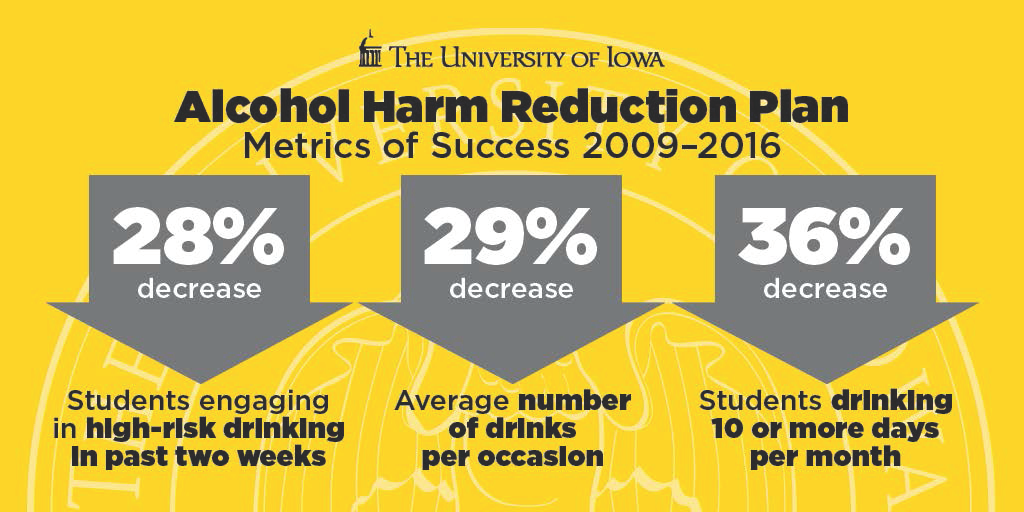The University of Iowa is making progress curtailing high-risk undergraduate drinking and its negative effects, according to new data from the National College Health Assessment (NCHA) survey.
Compared to data from 2009, 28 percent fewer UI undergraduates engaged in high-risk drinking in the two weeks prior to the annual survey, which collects anonymous data on undergraduate health practices, behaviors, and perceptions.
Results also show that since 2009, UI undergraduates consume 29 percent fewer drinks on average per occasion, and 36 percent fewer UI undergraduates drink 10 or more days a month. Despite the progress, the data shows UI students continue to drink more and experience more negative consequences than college students nationally.

“Our statistics are the best they’ve ever been, and we are improving faster than the national average,” says Tom Rocklin, UI’s vice president for student life. “We’re encouraged by our progress, but know there are still areas we need to continue to address and that there’s more hard work to be done.”
The recently published 2016–2019 UI Alcohol Harm Reduction (AHR) Plan, outlines a comprehensive list of evidence-based strategies to continue addressing the harms of college drinking. The UI is one of the only Big Ten universities that has developed a detailed plan, measures the outcomes of strategies, and reports publically on progress and efforts.
The Alcohol Harm Reduction (AHR) Advisory Committee, a broad-based group of faculty, staff, and students, helped develop the plan, which used 2015 NCHA data to inform its recommendations since 2016 data wasn’t available yet.
The NCHA survey measures high-risk drinking as consuming five or more drinks on one occasion in the last two weeks.
“The primary goal of UI’s harm reduction work is to decrease high-risk drinking, which increases the likelihood of negative consequences, such as injuries or blackouts,” says Tanya Villhauer, associate director for student wellness and harm reduction initiatives at UI. “We use the data to help inform the recommendations made in the AHR Plan to help promote student success.”
The UI’s new AHR plan identifies targets for further reduction of undergraduate drinking by 2019. It’s the third three-year plan since the AHR Advisory Committee formed in 2009.
Goals include raising student accountability and decreasing high-risk drinking among current students.
To achieve those goals, the plan outlines comprehensive strategies, some of which are borrowed from the National Institute on Alcohol Abuse and Alcoholism (NIAAA) Alcohol Intervention Matrix (CollegeAIM), a tool that provides research-supported intervention strategies to address college drinking.
The UI plans individual interventions, such as the continued implementation of the Brief Alcohol Screening and Intervention for College Students (BASICS), which provides personalized feedback to students about their drinking and challenges common misconceptions about the prevalence of drinking among their peers.
According to NCHA data, UI undergraduates estimated that 62 percent of their peers drank alcohol on more than 10 of the last 30 days. However, data showed that fewer than half that estimated number, only 23 percent of undergraduates, had actually done so.
Susan Assouline, chair of the AHR Advisory Committee, says research also indicates that parental involvement and lowering access to alcohol through community partnership is key.
“It’s not possible to overstate the importance of partnership among the primary stakeholders, including our students, their parents, and the community at large,” says Assouline, who is also a professor in the College of Education and director of the Belin-Blank Center. “Such partnerships ensure that there is multi-level communication that promotes safety, which can only enhance the success of our students and benefit the community.”
During Orientation, parents of UI undergraduates attend presentations and receive a handbook containing research-tested methods for talking with students about college drinking.
The UI also partners with local government, police, and businesses in the Partnership for Alcohol Safety to reduce underage access to alcohol and coordinate enforcement of policies such as the local 21-only ordinance, which prohibits people younger than 21 from being in bars past 10 p.m.
“High-risk drinking does not have to be an inherent part of the college experience, and the development of the AHR plan shows that the UI is committed to changing campus alcohol culture,” says Villhauer.
Read the 2016–2019 Alcohol Harm Reduction Plan at https://vp.studentlife.uiowa.edu/initiatives/alcohol-harm-reduction.
Read about the Partnership for Alcohol Safety at https://vp.studentlife.uiowa.edu/initiatives/partnership-for-alcohol-safety.
View the National College Health Assessment Summary of the University of Iowa results from the spring of 2016 here: https://studenthealth.uiowa.edu/wellness/ui-health-data.